Beginning with a new art medium can sometimes be overwhelming. So many brands, so many flavors.
In this section I’ll tell a thing or two about the products I use (or used to use)and what their advantages and disadvantages are (in my opinion at least).
Mind, I can only talk about my own experiences with these products, your experience can be totally different because your style may be different, or somehow materials that work for me, don’t work for you or vice versa.
Just know that I’m not affiliated to any brand at all and these are just my findings, for what they’re worth to you
General
Colored pencils come in different brands, types and colors. And then there is the way the pencils bind the pigment. Some are oil based, others are wax based.
What is the difference between wax based and oil based?
For starters, wax based pencils are softer than oil based pencils. They give off less pigment and are good for layering on top of each other. However, oil based pencils layer more pigment, decreasing the need to layer.
Oil based pencils are more expensive than wax based pencils.
Wax based pencils tend to leave what they call Wax Bloom on top of the drawing. This is the result of the wax in the pigment rising to the top. This can be prevented by using a fixative for colored pencils. Once wax bloom has appeared, it can be removed using a piece of cloth or, to prevent smudging, a cotton swab. Oil based pencils do not have wax bloom and do not require fixative.
Wax based pencils break more easily than oil based pencils.
Can I mix oil and wax based pencils?
Yes you can, most of the times anyway!
Pencils of different brands an be used together. There’s no ‘rule’ on what to use first. You can alter on any layer. Just determine what works for you.
Colored Pencils
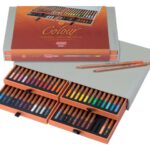
Bruynzeel Design
Bruynzeel Design Colored pencils are wax based pencils. They apply in a smooth way and can take quite a few layers, provided you use suitable paper. The colors are rich and vibrant.
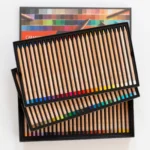
Caran D'Ache Luminance
The Luminance pencils are considered one of the best in the league. I personally love them as they apply and layer easily. This pencil is the most expensive in my list, but I think everyone should at least own the 3 primary colors, a Chinese White and a black Luminance pencil. Luminance pencils are Wax based

Cretacolor Studioline
These come in a tin, together with graphite pencils and watercolor pencils. I was not impressed by either the pencil (how it felt when drawing) nor the amount of pigment it layered. Nice for study, but personally I would not recommend these. Nice for the kids though!
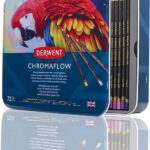
Derwent Chromaflow
Chromaflow pencils are wax based soft creamy pencils. The pigments are rich and the pencil easily layers the pigment on the paper. I do however find I have to sharpen them a lot. This is mainly due to the soft core, that blunts out the tip too fast to my liking, making it challenging to use these pencils for finer details.
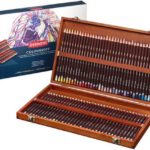
Derwent Coloursoft
Derwent Coloursoft also are wax based pencils. They blend very easy and layering the pigment is childsplay. The palette contains a great range of colours. Although the core is quite soft, these pencils hold their sharp tip better than the Chromaflow pencils
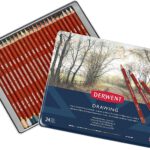
Derwent Drawing
Derwent Drawing comes in a modest range of 24 colors, are wax based and apply in a smooth way. They are great for final layers, for example the whiskers or top hairs of an animal or the detailing of the veins in a leaf
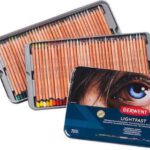
Derwent Lightfast
With the oil based lightfast pencils, Derwent added a pencil that can easily compete with the Faber Castell Polychromos and the Luminance by Caran d'Ache. I was pleasantly surprised with the ease of blending. You can use oil-mediums for blending, making the artworks done with Lightfast almost look like paintings. These pencils however,aren't the cheapest on the block.
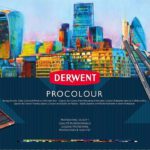
Derwent ProColour
Derwent ProColour is a wax based pencil but when using it, it feels like I'm drawing with an oil based pencil. The tip is sturdy, allowing me to use these pencils for finer details. I've not yet worked out the easiest way to blend these pencils.
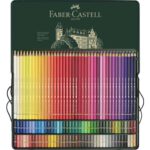
Faber Castell Polychromos
A definite Got-To-Have pencil. Easily on the top of the list. These oil based pencils lay down pigment as if they are wax based, but blend like a charm, layer like a charm and can be used with oil mediums for even better blending. Like the Lightfasts of Derwent they can easily appear as being painted.
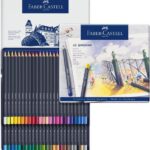
Faber Castell Goldfaber
Great pencil for starters or people who are satisfied with a smaller range of colors (after all, you can blend any color if you just have red, yellow and blue). I would not use these for a commissioned piece, but they are definitely suitable for practice purposes and beginning artists. Affordable and satisfying pencils
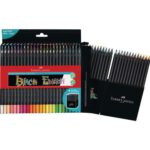
Faber Castell Black Edition
Bought these just for the fun of it. They are supposed to be unbreakable but unfortunately, that doesn't quite reflect my experience with them. However, these pencils hold very nicely on black paper, making them a nice addition to the traditional pencils. They are wax based and really soft and smooth to use. Recently Faber Castell added many more colors to the palette so I'm afraid I'll have to expand my collection of these, just because I like to use these on black paper

Koh - i - Noor Hardtmuth Polycolor
Koh-i-Noor Polycolors are among the cheaper brands. They do however not feel like cheap when you use them. I was pleasantly surprised by the colors when I swatched them. These pencils have a mixture of oil and wax, making them less smudgy. I haven't used them in a piece yet, so I may come back to add to this review later on.
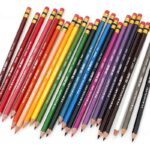
Prismacolor ColErase
These are wax based color pencils that come with an eraser on each pencil. The pencils are quite hard and (for me) not layering easy on my paper. However the harder tip makes them suitable for adding in finer details. I haven't used the erasers, so I have no idea of they actually erase the colors.
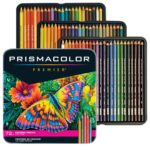
Prismacolor Premier
Together with the Polychromos, these Prismacolor Premiers are my favorite pencils. They are wax based and work fine together with the polychromos, adding many more colors to the palet and allowing the oil pencils on top. I started out by trying one....and decided I needed all colors.

Prismacolor Verithin
These are what the name says, very thin. The thin leads require that they are harder, to prevent them from breaking. This makes them perfect for finer details but not for layering larger areas. Verithin pencils are wax based
Suitable paper for colored pencils
There are so many different kind of drawing papers available, that it would be impossible to list all of them. So below I list the ones I have worked with and tell you how I experienced them. As for all ‘reviews’ I share, I’m not affiliated with any brand or art store whatsoever.
Some art-stores offer various test-sets of papers, pencils etc. I recommend you make use of that opportunity to prevent spending a lot of money on something that doesn’t work for you.
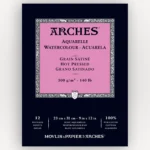
Arches Hot Pressed (Satiné) Aquarelle
Maybe not the first kind of paper you'd think about, but this hot pressed paper works surprisingly well with colored pencils, as do many more hot pressed aquarel or watercolour papers. Hot Pressed papers (also known as HP or Satiné) are usually a bit smoother than cold pressed (CP, grained) papers. This is due to the fact that these papers are pressed in between heated rollers or plates, that press down the paper just a bit smoother than the cold rollers and plates do.
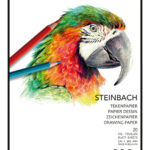
Aurora Steinbach paper
This paper has a bit of a grainy, yet still rather smooth surface which results in both ease of layering, as coverage of the paper itself.
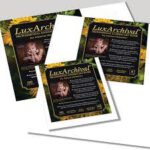
Brush & Pencil LuxArchival
This Archival paper has a sanded feel and takes up pigment very easy. For me it was harder to get full coverage when drawing with colored pencils but that's because I still have to get used to this amount of grain for colored pencil. The paper is sturdy and holds many layers. This is not cheap paper but it will stand the test of time.
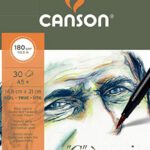
Canson C' à Grain
Slightly grained paper. Works very well with colored pencils. Holds less layers as (for example) the Luxarchival paper but has a nice feel to it
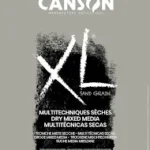
Canson XL Sand Grain
This paper has a feel comparative to the LuxArchival. It's sanded and comes in two different colors. In opposite of the LuxArchival, this paper is very affordable, takes up pigment easy and the colored paper adds to the colors of the drawing
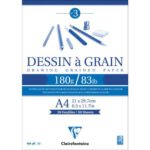
Clairefontaine Dessin à Grain
For me personaly I like this paper better for graphite drawing than for colored pencil drawing. But it works with colored pencils too. Just not my favorite for the job
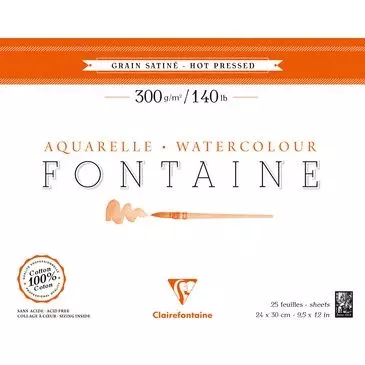
Clairefontaine Fontaine HP Grain Satiné
Like the Arches a HotPress Aquarel/Watercolour paper. I very much like the HP papers with colored pencil. And since the papers also work for watercolours, it's almost like a luxury mixed media paper. I would strongly suggest you make at least one attempt with Hot Pressed Watercolor paper for colored pencil. Any brand

Derwent Lightfast paper
This paper is specifically released to be used with the Derwent Lightfast colored pencils but obviously, other pencils also work on this paper. For me, price-quality are out of balance. It's a nice paper but I do not feel like it adds to the experience in the same amount as it adds to the price.

Hahnemühle Leonardo HP Satiné
The third Hot Pressed watercolour paper and by far the sturdiest paper in this post. With it's 600 g/m2 this is a thick yet reliable paper. Smooth to the feel and easy to draw on.
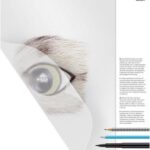
Kangaro Drafting Film
I heard a lot about working on drafting film so I had to try out this paper. It has a velvety feel to the touch and it's a bit transparent (like Calque tracing paper). I did not finish a drawing on this paper because I did not like the feel of the paper at all, and the resemblance with tracing paper kinda put me off. But I've seen many beautiful drawings on this kind of paper so it works with Colored Pencil
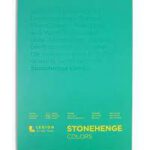
Stonehenge Colors
This block of paper contains sheets in 5 different neutral colors. I would strongly suggest you try out colored paper for your colored pencils because it adds to the artwork. That being said, this paper is great for colored pencils, but can also be used for graphite pencils. It takes on plenty of layers, feels smooth and covers easily.
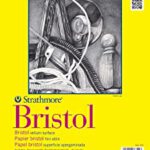
Strathmore Bristol Vellum
This is not the transparent vellum paper, but a heavyweight (270 g/m2) paper with a slight grain (compared to Bristol Smooth paper). Though primary meant for graphite drawings, it takes up enough layers to work on with colored pencils. Great coverage of the paper itself due to the rather smooth feel. I love this paper a lot!
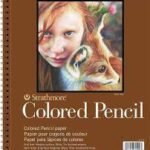
Strathmore Colored Pencil
This paper has tooth, meaning it takes quite a few layers to cover the paper entirely. Very suitable for loose drawings but if you want the 'painted' effect, this may not be the paper you need.
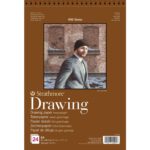
Strathmore Drawing
Another paper I prefer using for graphite techniques but also for colored pencils. It's sturdy paper that's sturdy. Not my nr 1, but definitely worth the price
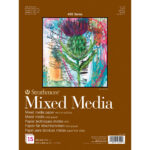
Strathmore Mixed Media
Nice paper with a slight grain that works well with both colored pencils as other dry ánd wet techniques. Allows for the combined use of watercolors and colored pencils for blending media into one artpiece. I need to use this paper more often, just to practice my watercolor skills and to still be able to use my colored pencils.
Blending
Colored pencils, like other media, need blending to smooth out those layered colors. There are various blending techniques and at least that many blending tools. Like the ones below.

Zest-It blending fluid
It takes just a little bit of fluid to blend out a large section of your colored pencil layers. After it has dried up, you can easily add new layers. I find erasing after the use of blending fluid to get quite challenging. Just take a drop on a brush and blend the colors together.
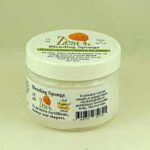
Zest-it blending fluid sponge
The same as the fluid but the sponge makes sure you do not use too much fluid. Can be cleaned and refilled from the bottle.
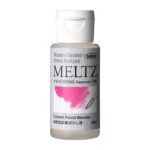
Meltz blending fluid
Colored pencil blender fluid, same idea, different brand. Specially created for Holbein colored pencils but also works with other brands of colored pencils

Derwent blending pens
Blending fluid in pen shape. Makes it easy to blend small areas without smudging the surroundings.
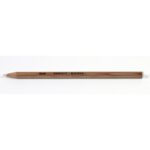
Blender pencils
Blender pencils come in different brands and are basically pencils that hold no pigment and that burnish/blend the underlaying colors together. Where blending fluids allow you to move around the pigment a bit, these pencils only press down the grain of the paper, leaving a smooth coverage on the paper. Not easy to add color after use.
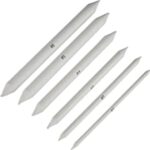
Blending stumps
These paper stumps are for blending. They can move the pigment around a bit. Can be used on dry media like chalk, charcoal, graphite and colored pencils but can also be used in combination with water (for watercolor artwork) or blending fluids
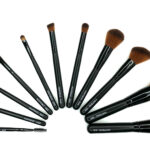
Brushes
One of my favorite blending tools is a simple makeup brush. Blending with a brush leaves room for both erasing as adding color because it hardly affects the paper grain. Ideal for inbetween blending.
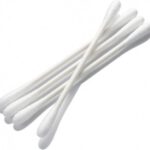
Cotton swabs
No blending tools at hand? Don't worry, if you have some cotton swabs, you can blend just as easy. Like the blending stump, you can use water or blending fluid to help move around pigment, or you can use it for dry media.
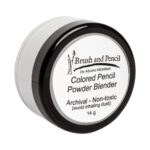
Brush & Pencil Colored pencil powder blender
The odd one out, this blending powder. Where all blenders mentioned before, are used on top of the colored pencil, this powder is used before the layering of colored pencil. With a tiny brush, you add the powder to the paper and then start drawing. Later on, you can use a brush to move the pigment around and blend the colors together.
Erasing
We all make mistakes so we need some tools to help us correct them. Like erasers. Erasers come in different shapes, tools, brands etc. Below a list of types of erasers
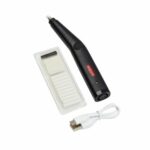
Electrical rasers (USB charged)
Worth the mention apart from the battery electrical rasers, simply because they are durable. Comes with a 4.8mm and a 2.8mm eraser tip for larger of finer erasing goals. Tip: practice on a test paper because it tends to 'dance' on the paper if you're not used to these. Make sure you know how to hold and use them before erasing in your beautiful artwork.mm
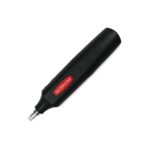
Electrical eraser (battery powered)
Same as the USB Charged erasers. There are different brands that have these kind of erasers, and they come in different prices. Available with 4.8mm eraser tips and 2.8 eraser tips
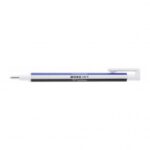
Tombow Mono Eraser
This refillable eraser pen comes in two shapes, the round 2.5mm and the square 2.5x5mm eraser. They are helpful for detailed erasing.
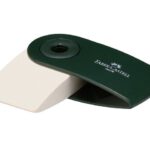
Hand erasers
Again, many shapes, brands and variety of erasing materials. I've picked this sleeved one because it really erases well on colored pencils and the shape helps for both erasing larger areas as smaller areas. Tip: test out on a test-sheet to see what the eraser will do to your paper. The harder you need to press to erase, the more the paper will be affected.
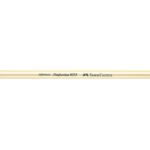
Eraser pencils
An ordinary pencil but instead of a graphite or colored lead, it contains an eraser. Can be sharpened with a pencil sharpener. The small tip (after sharpening) can help with even the tiniest details
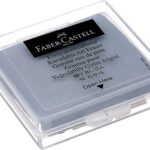
Kneeded Eraser
Kneaded erasers are not suitable for erasing back to the paper surface but can be used to lift up some of the pigment to help highlight (or blend) colors.
Other tools
To finish this page, I conclude with some other useful tools when drawing with colored pencils.
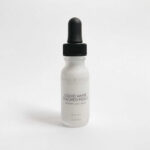
Liquid white colored pencil
This liquid white colored pencil can be used to add the ultimate highlights, even when the paper itself does not allow for more layers. The light sparkle in the iris? Just use it with a small brush. Make sure to close the container because it dries really quick
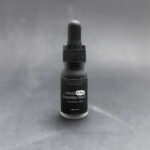
Liquid black colored pencil
Just like the white but then for the darkest shades of black even your colored pencils won't give you.
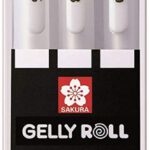
Gel pens
Like the liquid white, many people use these white gel pens for adding the highlights in their drawings. I'm not very charmed by the unnatural look of the white, so I don't use these. but since many have found a way to use them to their satisfaction, I decided to mention them anyway.
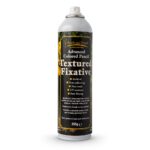
Brush & Pencil Texture fixative
A must have for those that keep layering their colors and find out the paper won't take up any more pigment, just a few layers too soon. This texture fixative adds new texture to the blended layers on your paper, so you can add some more layers after all
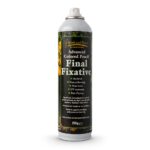
Brush & Pencil Final Fixative
Wax based colored pencils tend to smudge when not fixed. This fixative helps keeping everything in place, for years to come!
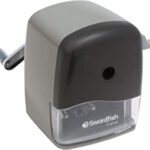
Sharpener
Every pencil needs to be sharpened every once in a while. They come in nice small (and cheap) hand-sharpeners all the way to the most expensive electrical desk sharpeners. Just know that every sharpener eventually will go blunt. Some sharpener brands offer replacable blades. You can extend the lifespan of your sharpener blades by occasionally sharpening a woodless graphite pencil
